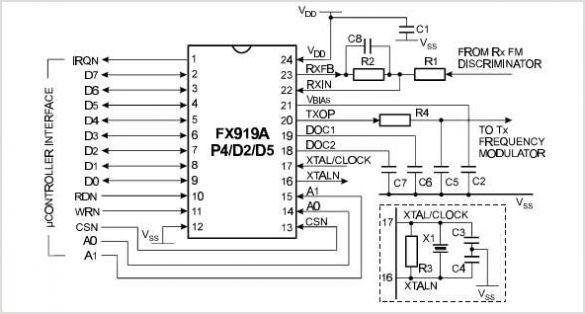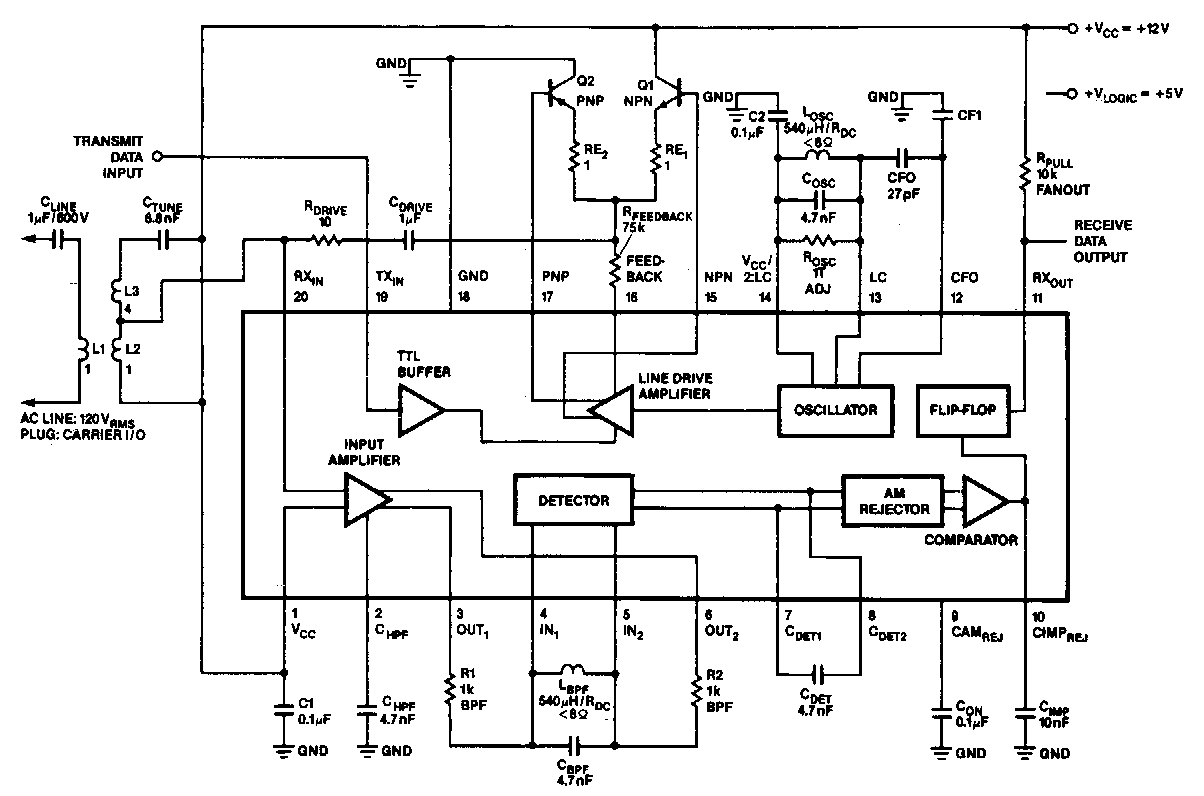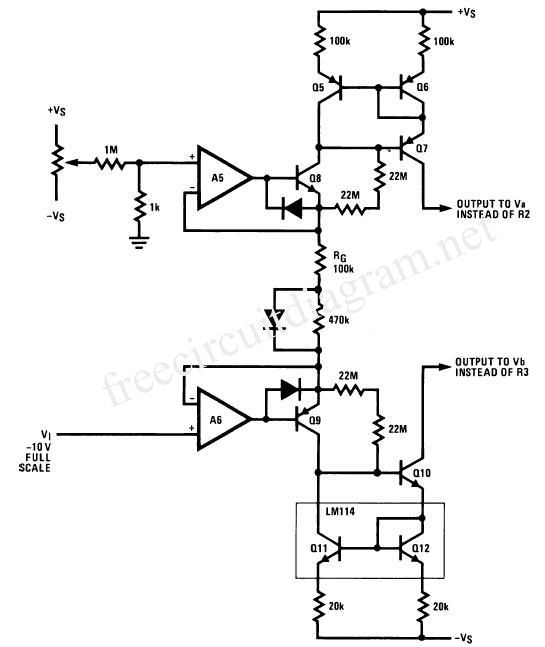
FX919A 4-Level FSK Modem Data Pump

This application note details the operation and features of the FAN7601, a BCDMOS programmable frequency current mode PWM controller designed for offline adapter applications and auxiliary power supplies. To minimize power loss during light and no-load conditions, the FAN7601 operates in burst mode and incorporates a startup switch to reduce losses in the startup circuit. With the internal startup switch and burst mode operation, it can deliver an output power of 0.5W with less than 1W input power when the input line voltage is 265V. Under no-load conditions, the input power is below 0.3W. The FAN7601 includes a latch protection pin for system protection, such as over-voltage protection and thermal shutdown. The internal over-voltage protection function disables the IC when the supply voltage reaches 19V. Additionally, a soft start function is included, with the soft start time being adjustable. A block diagram illustrating the system is provided.
The FAN7601 is a sophisticated device that integrates several essential features for efficient power management in electronic circuits. The BCDMOS technology utilized in the FAN7601 allows for high-performance operation with reduced power consumption, making it suitable for applications requiring reliability and efficiency. The burst mode operation is particularly advantageous in scenarios where the load varies significantly, as it enables the controller to minimize energy usage when demand is low.
The startup switch plays a crucial role in enhancing the efficiency of the startup process. By reducing the losses typically associated with the startup phase, the FAN7601 ensures that the system can achieve operational readiness with minimal energy expenditure. This feature is particularly beneficial in applications where energy efficiency is paramount.
In terms of safety and reliability, the latch protection pin provides an essential safeguard against potential faults, such as over-voltage conditions. The internal over-voltage protection mechanism ensures that the IC automatically shuts down when the voltage exceeds 19V, thereby preventing damage to the system. The thermal shutdown feature further enhances the reliability of the device by protecting it from overheating, which can lead to catastrophic failures.
The adjustable soft start function is another critical aspect of the FAN7601, allowing designers to customize the ramp-up time of the output voltage. This feature aids in reducing inrush current during startup, which can be detrimental to both the power supply and the connected load. By controlling the soft start duration, the designer can mitigate the risk of voltage spikes that may otherwise occur during the initial power-up phase.
Overall, the FAN7601 is a versatile and efficient PWM controller that incorporates advanced features aimed at optimizing performance and enhancing system reliability in various power supply applications. Its design is well-suited for integration into modern electronic systems that demand high efficiency and robust protection mechanisms.This application note describes the operation and features of the FAN7601. This device is a BCDMOS programmable frequency current mode PWM Controller which is designed for off-line adapter applications and auxiliary power supplies. To reduce power loss at light and no load, the FAN7601 operates in burst mode and it includes a start-up Switch to re
duce the losses in the start-up circuit. Because of the internal start-up Switch and burst mode oper- ation, it is possible to supply an output power of 0. 5W with under 1W input power when the input line voltage is 265V. On no load condition, input power is under 0. 3W. The FAN7601 offers a latch protection pin for the protection of the system e. g. over voltage protection and/or thermal shutdown. The internal over voltage protection function shuts down the IC operation when the supply voltage reaches 19V.
In addition, a soft start function is provided, and the soft start time CAN be varied. Figure 1 shows a block diagram for the 🔗 External reference
The FAN7601 is a sophisticated device that integrates several essential features for efficient power management in electronic circuits. The BCDMOS technology utilized in the FAN7601 allows for high-performance operation with reduced power consumption, making it suitable for applications requiring reliability and efficiency. The burst mode operation is particularly advantageous in scenarios where the load varies significantly, as it enables the controller to minimize energy usage when demand is low.
The startup switch plays a crucial role in enhancing the efficiency of the startup process. By reducing the losses typically associated with the startup phase, the FAN7601 ensures that the system can achieve operational readiness with minimal energy expenditure. This feature is particularly beneficial in applications where energy efficiency is paramount.
In terms of safety and reliability, the latch protection pin provides an essential safeguard against potential faults, such as over-voltage conditions. The internal over-voltage protection mechanism ensures that the IC automatically shuts down when the voltage exceeds 19V, thereby preventing damage to the system. The thermal shutdown feature further enhances the reliability of the device by protecting it from overheating, which can lead to catastrophic failures.
The adjustable soft start function is another critical aspect of the FAN7601, allowing designers to customize the ramp-up time of the output voltage. This feature aids in reducing inrush current during startup, which can be detrimental to both the power supply and the connected load. By controlling the soft start duration, the designer can mitigate the risk of voltage spikes that may otherwise occur during the initial power-up phase.
Overall, the FAN7601 is a versatile and efficient PWM controller that incorporates advanced features aimed at optimizing performance and enhancing system reliability in various power supply applications. Its design is well-suited for integration into modern electronic systems that demand high efficiency and robust protection mechanisms.This application note describes the operation and features of the FAN7601. This device is a BCDMOS programmable frequency current mode PWM Controller which is designed for off-line adapter applications and auxiliary power supplies. To reduce power loss at light and no load, the FAN7601 operates in burst mode and it includes a start-up Switch to re
duce the losses in the start-up circuit. Because of the internal start-up Switch and burst mode oper- ation, it is possible to supply an output power of 0. 5W with under 1W input power when the input line voltage is 265V. On no load condition, input power is under 0. 3W. The FAN7601 offers a latch protection pin for the protection of the system e. g. over voltage protection and/or thermal shutdown. The internal over voltage protection function shuts down the IC operation when the supply voltage reaches 19V.
In addition, a soft start function is provided, and the soft start time CAN be varied. Figure 1 shows a block diagram for the 🔗 External reference





